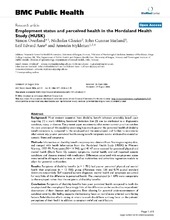Employment status and perceived health in the Hordaland Health Study (HUSK)
Øverland, Simon Nygaard; Glozier, Nicholas; Mæland, John Gunnar; Aarø, Leif Edvard; Mykletun, Arnstein
Peer reviewed, Journal article
Published version
Permanent lenke
https://hdl.handle.net/1956/1925Utgivelsesdato
2006-08-29Metadata
Vis full innførselSamlinger
Originalversjon
https://doi.org/10.1186/1471-2458-6-219Sammendrag
Background: Most western countries have disability benefit schemes ostensibly based upon requiring (1) a work inhibiting functional limitation that (2) can be attributed to a diagnosable condition, injury or disease. The present paper examines to what extent current practice matches the core premises of this model by examining how much poorer the perceived health of disability benefit recipients is, compared to the employed and the unemployed, and further to examine to what extent any poorer perceived health among benefit recipients can be attributed to mental or somatic illness and symptoms. Methods: Information on disability benefit recipiency was obtained from Norwegian registry data, and merged with health information from the Hordaland Health Study (HUSK) in Western Norway, 1997–99. Participants (N = 14 946) aged 40–47 were assessed for perceived physical and mental health (Short Form-12), somatic symptoms, mental health, and self reported somatic conditions and diseases treated with medication. Differences associated with employment status were tested in chi-square and t-tests, as well as multivariate and univariate regression models to adjust for potential confounders. Results: Recipients of disability benefits (n = 1 351) had poorer perceived physical and mental health than employees (n = 13 156); group differences were 1.86 and 0.74 pooled standard deviations respectively. Self reported somatic diagnoses, mental health and symptoms accounted for very little of this difference in perceived health. The unemployed (n = 439) were comparable to the employed rather than the recipients of disability benefits. Conclusion: Recipients of disability benefits have poor perceived health compared to both the employed and the unemployed. Surprisingly little of this difference can be ascribed to respondents' descriptions of their illnesses and symptoms. Even allowing for potential underascertainment of condition severity, this finding supports the increasing focus on non-disease oriented contributing factors. Rehabilitation efforts aiming at return to work should have a strong focus on the patients' perceptions of their health in addition to symptom relief and social factors.

